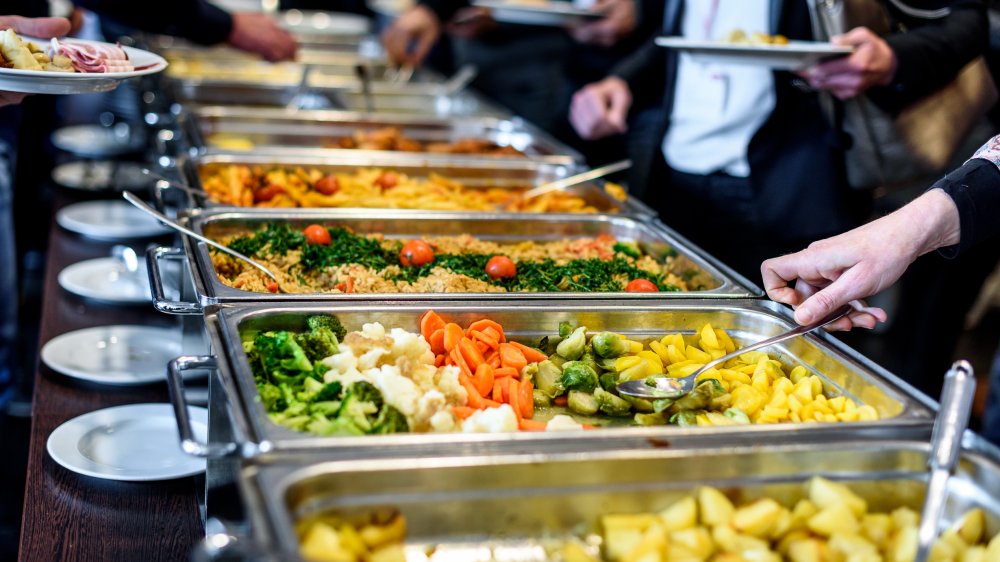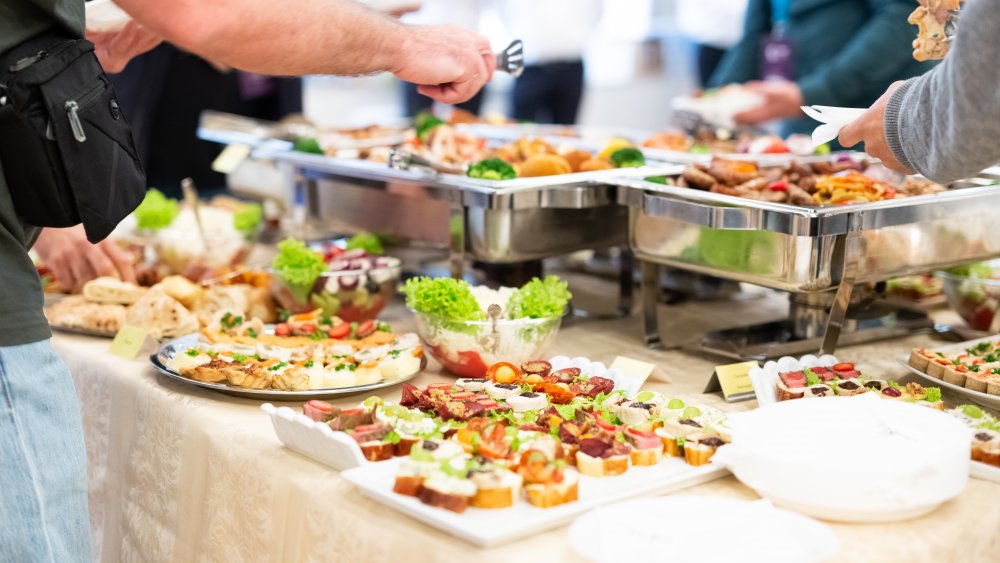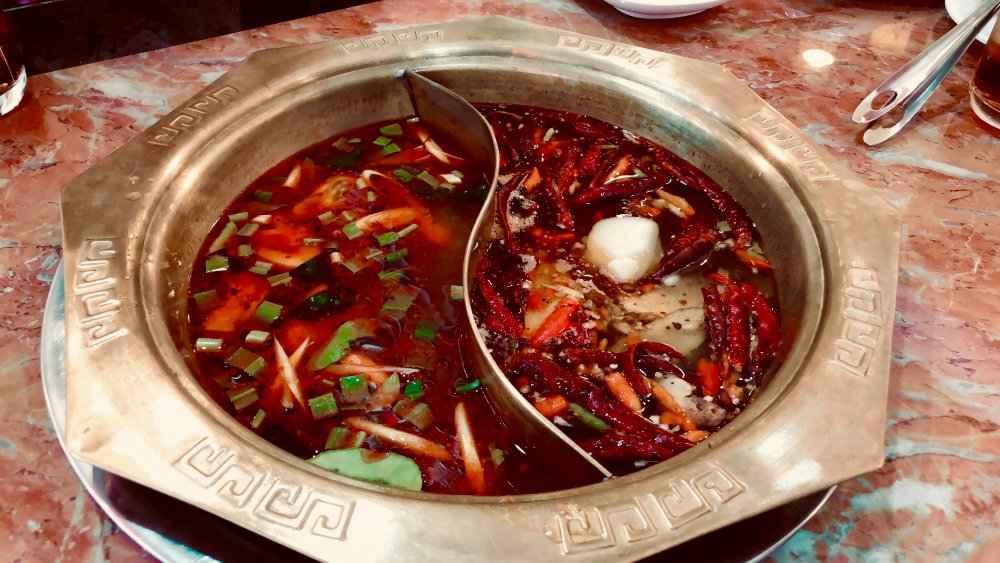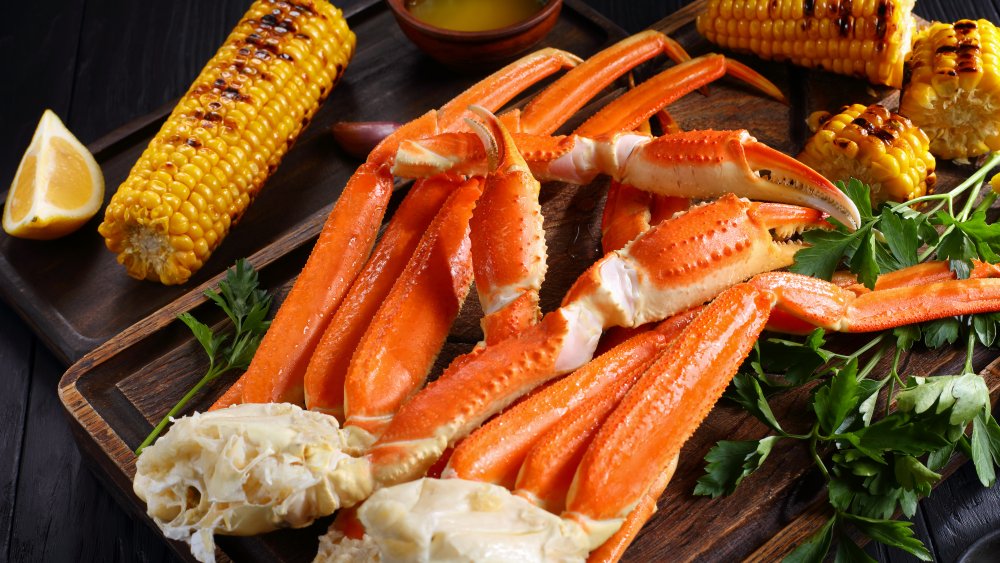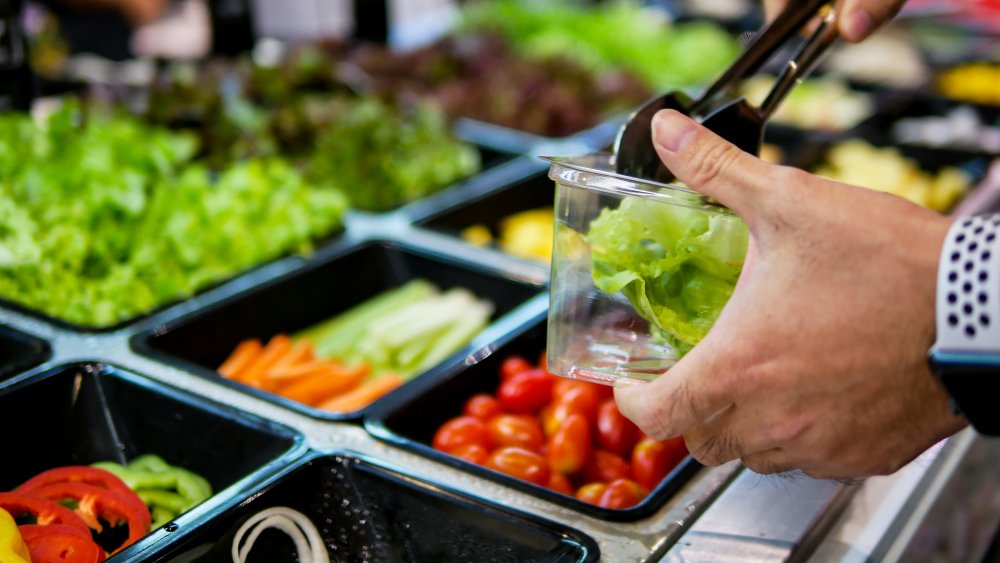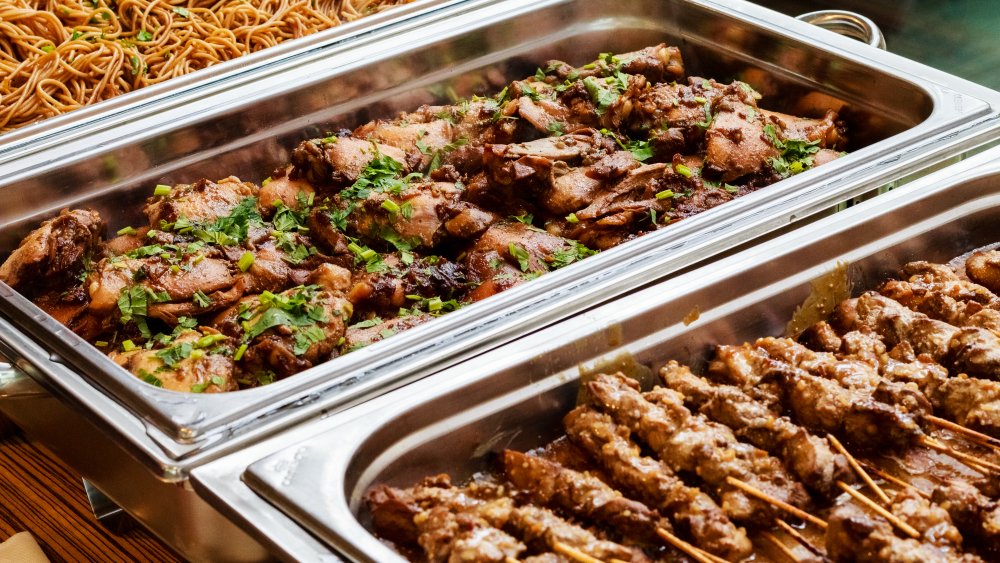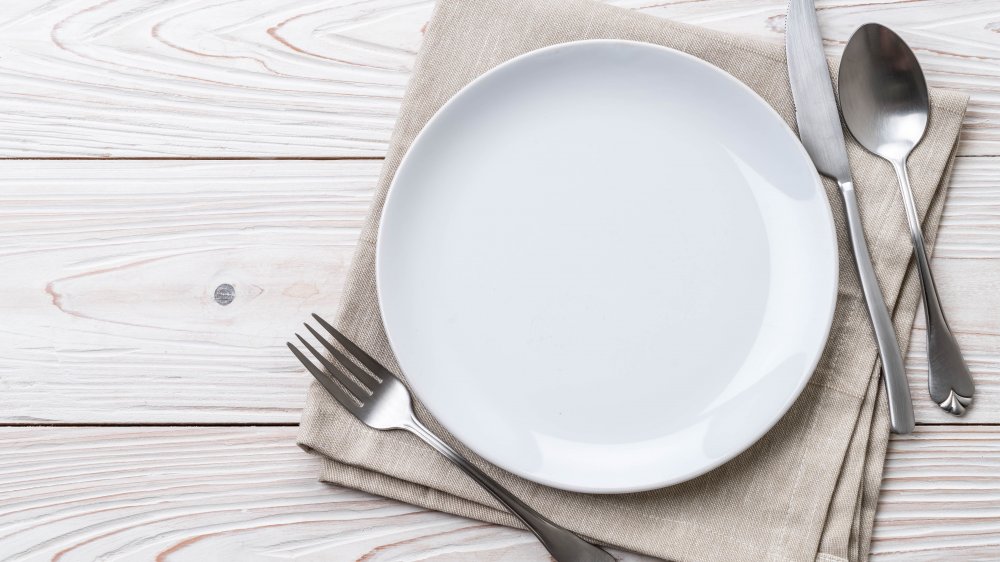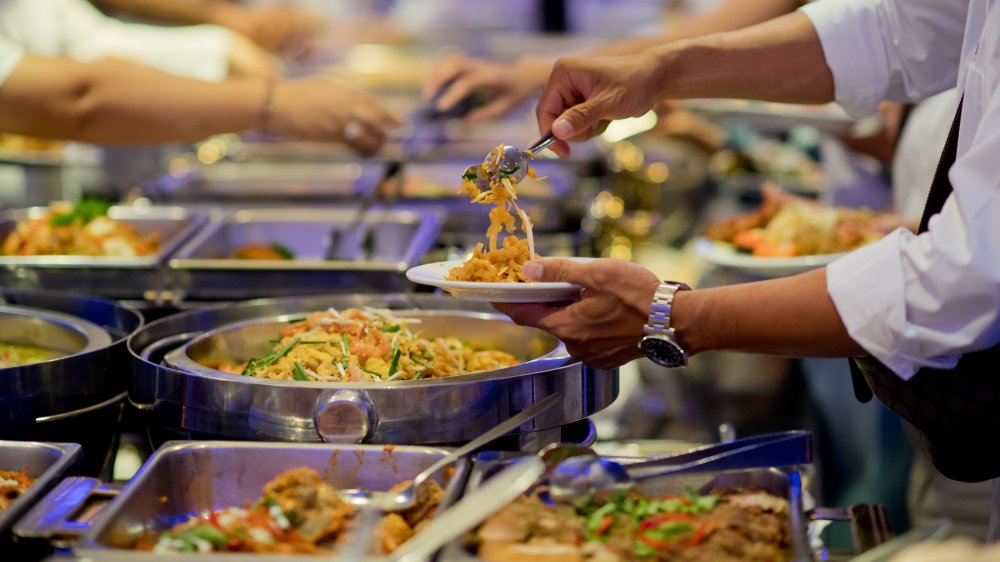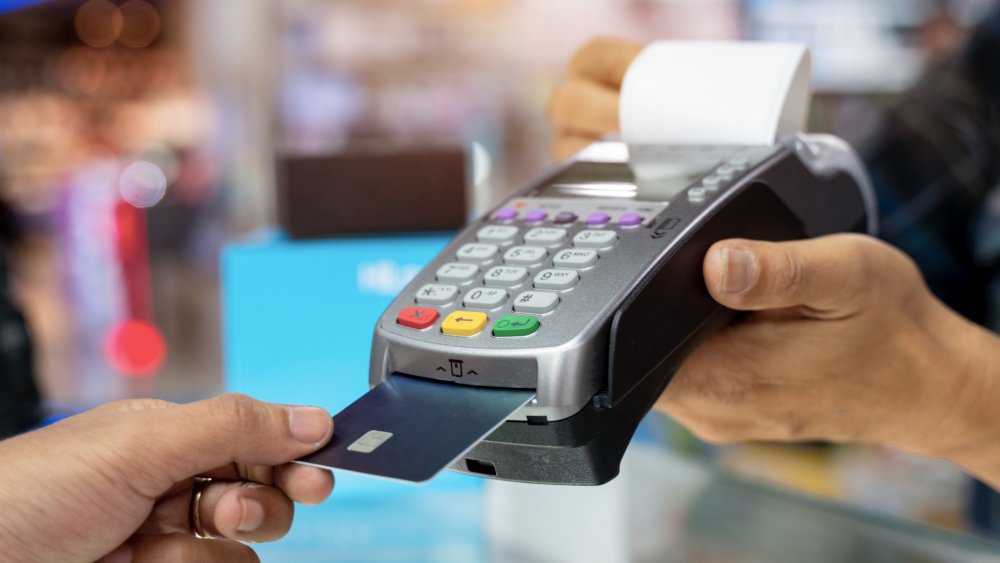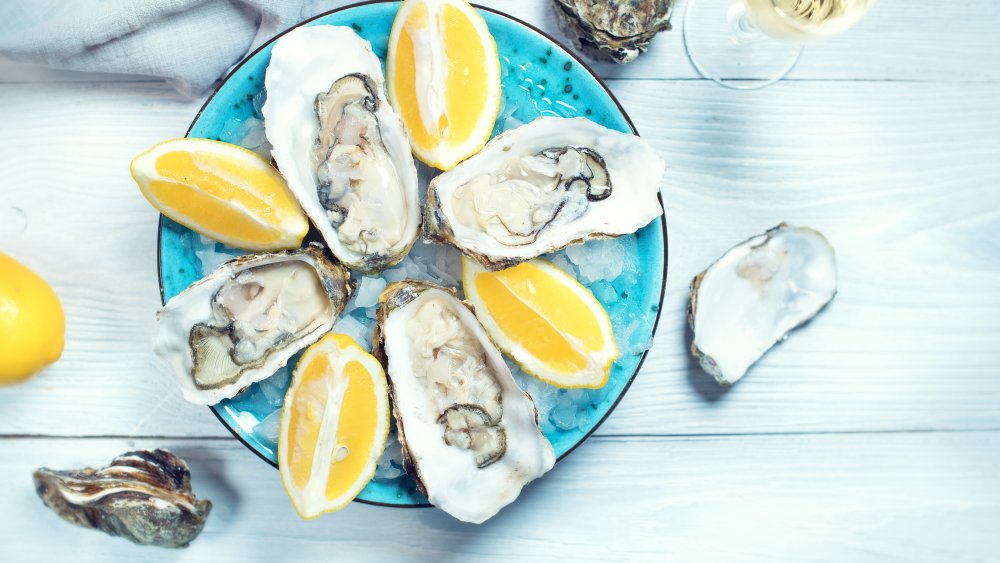The Sneaky Way Buffet Chains Are Scamming You
Walk into a typical buffet restaurant and you'll be greeted with a veritable football field of steaming hot dishes and tempting-looking desserts lining the expansive interior space. With the moniker "all you can eat," it's enough to make your mouth water and your hands twitch in anticipation of using those giant serving utensils to load up your plate.
As pointed out by The Hustle, the average buffet price may clock in at a not-so-cheap cost of roughly $20 per person, not including drinks, but when you can keep going back to the line to fill up plate after plate to your heart's content, that's still a good deal, right? Plus, buffets are a great option for families and groups — everyone gets to choose exactly what they want to eat and as much of it as they think they can handle. When everyone has differing opinions on what type of food to eat, buffets are an easy crowd-pleaser that's reasonably affordable.
The reality, though, is that buffet restaurants are in business to make a profit (duh), and that means using sneaky tricks to make you think you're getting a killer deal when in reality, that might not be the case. Before you head to the buffet for your next chow down, brush up on your knowledge on how buffet chains could be scamming you. By making a few smart choices when you grab your plate, you'll be more likely to enjoy a slamming good deal when hitting the buffet.
Buffets shift some of the work over to the customer
A big part of the draw of eating out is that someone else is doing all the work for you, right? You just sit down, place your order, make any special requests you might have, then wait to be served. At the end of the meal, someone else picks up your plates and does the cleanup, too. That's not the case, though, at a buffet restaurant. Not only are you possibly paying as much or more for your meal as you would at a standard restaurant, but you're also doing a lot of the work that's typically relegated to a waiter or waitress.
Sure, you get to pick and choose from lots of different food options, and you can load up multiple plates if you're so inclined, but buffets are saving lots of money by getting you to do some of the work yourself.
The Hustle points out that buffet management reduces the need for waitstaff while simultaneously minimizing the costs of cooks because food is prepped in huge batches without specialization for individual customers. The remaining staff simply replaces food as needed, washes dishes, and wipes down tables. This work requires little skill or interaction with customers, which means it comes cheap. So yeah, you get more options for food selection at buffets, but the overall experience doesn't give you the full-service break from the work of enjoying a meal. Is it worth it? Maybe. But maybe not.
Buffets are likely serving you repurposed food
Here's a buffet scam you really need to know: That soup you're about to chow down on at your favorite chain? It may just be made from scraps of yesterday's entrees.
All restaurants have to consider the high cost of food waste — it's a part of the business — but it's especially costly at all-you-can-eat buffets. Customers often seem less concerned with failing to finish their meals when they know they can go back and get something else if they don't like what they selected the first time. Plus, it's hard to guess exactly how much of each menu item is needed for the day. The Hustle says that between 5 to 25-percent of every food dish at a buffet ends up in the trash. When a restaurant is already working in the margins to turn a profit, it's important to reduce this expense anyway it (reasonably) can. Reusing food scraps is one tried-and-true method for turning leftovers from a meat dish into a soup. Likewise, plates of veggies can be thrown into different types of casseroles.
To be fair, it's not like buffets are taking scraps of uneaten food from customer's plates to repurpose in other ways — they're simply reusing the leftovers that no one previously touched. Even still, it just seems a bit suspicious when you don't know if the food you're eating was actually cooked the same day you're sitting down to enjoy it.
Some of the buffet seafood may be questionable
Some buffet tricks are downright gross and you'd be wise to consider steering clear of crab legs and oysters at the buffet. Sure, you may think eating these more expensive items is one of the ways to maximize your buffet experience and get a good deal, but if you do, you just might end up sick a few hours later. According to a Diply article that recounts a Reddit thread of questions and answers posted by a buffet manager, the one item he would suggest customers avoid is the crab legs.
"I have seen Chinese buffets at the fish market going and buying the bottom of the barrel seafood including crab legs past their prime," the manager said. "And then they don't steam them properly to save on volume." He added that oysters fall into the same category and noted that they're often sourced from grocery stores past their ideal date of sale. Yikes! Eating seafood past its prime is never a good idea.
The one silver lining in this possible seafood debacle? The sushi is actually something you can usually trust, assuming you're eating at a popular, busy buffet. The buffet manager on Reddit noted that health codes regarding raw fish are very strict, which means it's not easy for buffet managers to cut corners when buying salmon or tuna fillet. So, skip the crab legs, but feel free to stock up on tuna rolls.
Buffets have a strategic layout
Think for a minute about the layout of a typical buffet. You walk in, you pick up your tray, then you're met with a long line of buffet food choices. You might first be met with a giant salad bar full of fruits and vegetables. Then you hit the pasta, pizzas, baked potatoes, and the many different types of bread. Maybe you then reach the hot plates of various meat-and-veggie entrees before you land at the finer cuts of meat and seafood. Sure, every buffet may be laid out a little bit differently, but if you think this order of food items is by chance, you'd be wrong.
An article on Babble Top points out that the starchy and inexpensive fillers of fruits, vegetables, and refined carbohydrates all help to fill up your plate before you even see the more expensive dishes. And The Hustle goes further, noting that 75 percent of buffet customers select food from the very first tray they come to, with 66 percent of the food they consume coming from the first three trays they encounter.
This means by the time you get to the items that cost the restaurant more, you have less room on your plate and you're more likely to take a smaller serving. Hence, reducing the expense of each customer's buffet experience. Trying to "beat the system"? Tour the buffet before you fill your plate, and then select the more expensive and savory items you're craving most.
Buffets know how to maximize the law of diminishing returns
Perhaps you remember your high school economics teacher explaining the law of diminishing returns. Basically, if you go to McDonald's and buy five Big Macs, with the goal of eating all five in the same sitting, you're going to find the first Big Mac delicious, but each successive Big Mac is going to be a little less satisfying. By the time you get to number five, you probably won't want to take another bite, and trying to force yourself to chew and swallow each bite is likely to feel uncomfortable, if not like downright torture.
Buffet chain managers understand this concept and an article on Studenomics points out that this is one of the ways buffets are able to eke out a profit. When you go into a buffet, you may feel like you're starving and can chow down on three or four plates piled high with food. But in reality, your stomach is only so big.
After your first plate (especially if you select inexpensive but filling salads, pasta, rice, and bread), that second plate isn't going to sound or taste as appealing. If you happen to finish your second plate, maybe you'll "make room" for dessert, but you're unlikely to want that many more plates of typical buffet fare. Buffet management relies on this concept, trusting that the majority of their customers won't end up wanting to eat a week's worth of food in a single visit.
Buffets are counting on you to order a fountain drink
Chances are the buffet you love to visit charges a flat rate for food, and a separate price for whatever drink you choose to imbibe in. On top of that, they probably provide extra-large drink glasses, and if they have servers delivering the drinks, these glasses are filled to the brim with ice, cutting down on the total amount of drink in each cup. This is all by design.
According to the Diply article that recounts a Reddit thread with a buffet manager, the cost to fill a fountain drink in his restaurant is 12 cents and the sales price is $1.59. That means even if you get 12 refills, the restaurant still turns a profit on that drink. Of course, these restaurants are counting on the fact that you won't want 12, 13, or 14 refills, and drink sales are a good way to pad profit margins. Even if you do happen to drink a lot of carbonated, belly-distending soda, an article on Studenomics notes that the more you sip down, the less total food you'll likely feel comfortable consuming. Either way, the restaurant wins when you order a fountain drink with your meal.
Small plates and small utensils mean you'll eat less at the buffet
If a typical dinner plate is 11 inches, expect dinner plates at your favorite buffet chain to be a little bit smaller than that. A big part of eating has to do with your eyes. If your plate looks full, you're going to assume you're eating a lot. Also, by the nature of a dish's size, you can only put so much food on a single plate. When you use a smaller plate, you serve less food overall. Whether or not you realize it, buffets are instilling portion control into your food choices. A Babble Top article points out that dishware manufacturers even have special lines of dishware geared to buffets called "half-size" dishes. Buffets want you to take less food with each serving.
Of course, you may notice the difference in size, but in the context of a buffet, you also know you can always go back for seconds, so small plates are no big deal, right? Maybe. Maybe not. You may just find that you feel full after eating a plateful and be less likely to go back for seconds (or thirds). And that's exactly what buffet management is counting on.
There's a reason some buffet items have big spoons and others have small tongs
Just as buffet restaurants are trying to control how much food you serve yourself by offering you smaller plates, they're also subconsciously affecting how much you take of any given food choice. For example, according to an article on Dollars & Sense, buffets are likely to use oversized serving spoons for inexpensive salads and side dishes, like mashed potatoes or fried rice, but smaller tongs or forks for more expensive items, like filet mignon. It's all in an effort to subconsciously influence your food choices — buffet management wants to "help you" limit how much you take of the more expensive items while encouraging you to load up on the cheap stuff.
And think about it — if you're given a giant spoon to serve up mashed potatoes or mac 'n cheese, you're likely to take a piling heap of these inexpensive items. And in the same light, if you're given small, awkward-working tongs to try to wrangle a piece of the pricier prime rib onto your plate, you're probably going to stop at a single small serving. Especially if there are people waiting behind you in line. None of this is by accident — it's all pre-designed to subliminally influence your food choices and serving sizes. Tricky, tricky, indeed!
Buffet pricing is all about psychology
Certainly, it's possible to find cheap prices at family-friendly buffets, but the trend for low-ball buffet prices has gone by the wayside and some buffets are even disappearing. This is due in part to research published in 2014 in the Journal of Sensory Studies. This study found that people who paid different prices for the exact same buffet (one group paid $4.00 while the other group paid $8.00), ended up feeling differently about their meals. Those who paid more found the meal more satisfying, perceiving the food to be of higher quality. Conversely, those who paid a lower price perceived the food to be worse, ultimately enjoying the meal less.
The conclusion by researchers was that people associate a higher price with higher quality, and they're more likely to experience satisfaction with their meal if they pay a little more. For buffets, this is huge information. For one, it informs the pricing strategy. By marking up prices to turn a profit, customers may perceive the food they're eating as better, even if buffets buy the bottom of the barrel ingredients. And second, offering low prices for all-you-can-eat may be a good marketing strategy to pull customers, but if people ultimately perceive the meal to be lower quality, they may not return. Ultimately, you end up getting scammed if buffets use low-quality food with a highly marked up price. Do your best to judge each bite for how it tastes, not how much you paid.
Buffets keep serving dishes smaller for more expensive items
The psychology of eating is an important subject for managers of all-you-can-eat buffets. As a result, managers employ tactics to get you to eat less of the expensive stuff while simultaneously trying to improve the perception you have of every bite. They also use what they know about social pressure to influence your food selection and the quantity of food you add to your plate.
To paint the picture, the Dollars and Sense points out that expensive items, like oysters, are often served on smaller platters with more attractive plating strategies and fewer available oysters. The idea is this: If there are only 10 oysters on a platter, and there's a line of people waiting to add oysters to their plates, every person is more likely to only take one or two, rather than 10, leaving oysters those who are waiting. After all, nobody wants to be the "pig" who takes all 10 oysters and leaves everyone else wide-mouthed gaping at the audacity.
Also, when items are plated beautifully with limited numbers, managers bank on the concept of supply and demand. The more supply there is, the less demand, and the lower the perceived quality of the item. Conversely, the less supply there is, and the higher the demand, the higher the perceived quality. This is true regardless of whether the restaurant plates past-due oysters bought at a local grocery store or paid a premium at a popular fish market.
